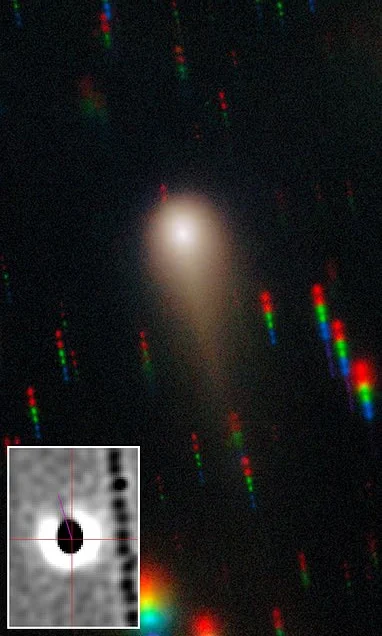Award-Winning Science Journalist | Volcanology PhD | Stories in @nytimes @sciam @NatGeo etc | Author: SUPER VOLCANOES 🌋 and HOW TO KILL AN ASTEROID 🚀☄️💥☠️
London, England
Joined May 2011
- Tweets 25,726
- Following 5,176
- Followers 24,823
- Likes 55,017
Pinned Tweet
NEW: @Int_Machines, @Astrolab_Space and @LunarOutpostInc have all built seriously cool, super-futuristic moon rovers. They’re competing to become the official mode of transportation for NASA’s Artemis astronauts.
And for @NatGeo, I test drove all three. nationalgeographic.com/scien…
Dr Robin George Andrews 🌋☄️ retweeted
PSA for all you 👽 3I/ATLAS people.
*ahem*
NASA ISN’T HIDING ANY INFO ABOUT IT. THERE ARE IMAGES OF IT LITERALLY EVERYWHERE FROM TELESCOPES BOTH IN SPACE AND ALL OVER THE WORLD
NASA CAN’T TALK ABOUT IT WHILE THE US GOVERNMENT IS SHUTDOWN
IT IS ALSO JUST A COMET
…cheers.
NEW: The interstellar object named 3I/ATLAS is many things: a time capsule from an ancient star, an effervescent icy voyager, a clue to the earlier days of the Milky Way.
You know what it definitely isn’t? An alien spacecraft. 😜
Me @newscientist newscientist.com/article/250…
Dr Robin George Andrews 🌋☄️ retweeted
NEW: Around Halloween, @dfuji1 saw two strange bright flashes on the Moon, one after the other. What were these spooky lights? Aliens having a rave?
Nope. They were asteroid impacts: a reminder that the Moon is a constant battleground.
Me @NYTScience nytimes.com/2025/11/05/scien…
Dr Robin George Andrews 🌋☄️ retweeted
NEW: @Int_Machines, @Astrolab_Space and @LunarOutpostInc have all built seriously cool, super-futuristic moon rovers. They’re competing to become the official mode of transportation for NASA’s Artemis astronauts.
And for @NatGeo, I test drove all three. nationalgeographic.com/scien…
Dr Robin George Andrews 🌋☄️ retweeted
If you get the chance to send @SquigglyVolcano on a quest to test drive moon rovers, do it: nationalgeographic.com/scien…
Dr Robin George Andrews 🌋☄️ retweeted
Hey there astronomy community! If anyone has any information or new footage of that impact flash on the Moon, please let me know—I’d love to see it/hear about it.
📸: @dfuji1
And then there were two! Another one caught last night as well. Two lunar impact events in a row caught by @dfuji1
Dr Robin George Andrews 🌋☄️ retweeted
NEW: The interstellar object named 3I/ATLAS is many things: a time capsule from an ancient star, an effervescent icy voyager, a clue to the earlier days of the Milky Way.
You know what it definitely isn’t? An alien spacecraft. 😜
Me @newscientist newscientist.com/article/250…
Dr Robin George Andrews 🌋☄️ retweeted
NEW: Some alien worlds orbiting right next to their stars seem to have a lot of water—but how?
A new study, using lasers and diamond anvils, has a wild answer: they are making all that water themselves by mixing hydrogen skies with magmatic hearts.
Me @ScienceMagazine 👇
NEW: Hurricane Melissa was such a monstrous tempest that it was literally shaking the Earth as far away as Florida, where seismometers picked up its stormquakes.
Here’s how seismometers can also shine a light on hurricanes long gone.
Me @sciam scientificamerican.com/artic…
Dr Robin George Andrews 🌋☄️ retweeted
Editors: if you let me write a story that’s essentially called “It’s a fucking comet, people. It’s just a comet” about 3I/ATLAS, with exactly that tone, I will basically write it for free.
🚨 Alright, Let’s Talk 3I ATLAS ☄️
There’s been a wave of speculation around Comet 3I/ATLAS, and for good reason — it’s not behaving like a normal comet. That’s a fact
With so much noise online, we wanted to go straight to the data and share what’s actually confirmed as of October 29, 2025 — no clickbait, no guesswork.
#Astronomers studying ATLAS have detected seven verified anomalies, each raising new questions about what this interstellar traveler really is:
1️⃣ Trajectory: Nearly aligned with the plane of our Solar System — a rare precision seen in only 0.2% of simulated cases.
2️⃣ Timing: Its closest pass to the Sun happened exactly when the Sun blocked our view, delaying discovery.
3️⃣ Mass & Speed: Roughly a million times more massive than ‘Oumuamua and traveling twice as fast.
4️⃣ Composition: Only 4% water vapor but unusually high CO₂ — a ratio almost never seen before.
5️⃣ Metals: The gas it releases is rich in nickel, not iron — a surprising chemical signature.
6️⃣ Light Polarization: Displays a negative polarization curve, unseen in any comet to date.
7️⃣ Tail Behavior: For weeks, its tail pointed toward the Sun — the opposite of normal — before flipping direction.
None of these details are speculation. They’re measured, peer-reviewed data.
The mystery is why.
Some researchers say the anomalies demand open-minded inquiry, even if that means entertaining unconventional possibilities. Others suggest nature itself still has surprises left to teach us.
And that’s what makes this moment so fascinating: we’re watching the scientific method unfold in real time — observing, testing, debating, and refining what we know about the universe.
Curiosity is how science moves forward.
Stay curious, stay critical, and keep looking up. 🌌
📊 Sources: NASA / ESA / JPL / IAU / Harvard–Smithsonian CfA
Some of this information is wrong.
Either way: it’s a comet. It’s a cool comet from interstellar space. But it’s definitely a comet.
This tweet is unavailable
Dr Robin George Andrews 🌋☄️ retweeted
Just to be clear - given recent drivel on line - Comet 3I/Atlas is a comet, made of carbon dioxide and water ices and bits of other stuff. It is entirely natural in origin, its orbit is as expected and it will whizz around the sun and then disappear off into the galaxy again. If it ever encounters another inhabited solar system in the far future I hope the living things there are more sensible than us and enjoy it for what it is - a visitor from elsewhere in the galaxy - a pristine lump of rock and ices which formed around a distant, maybe long-dead star billions of years ago and many light years away, just passing through. Isn’t that wonderful enough?









